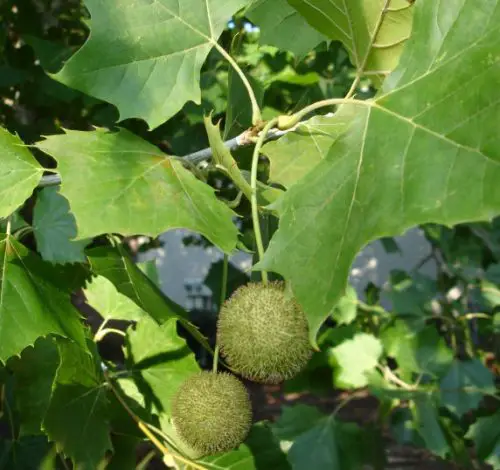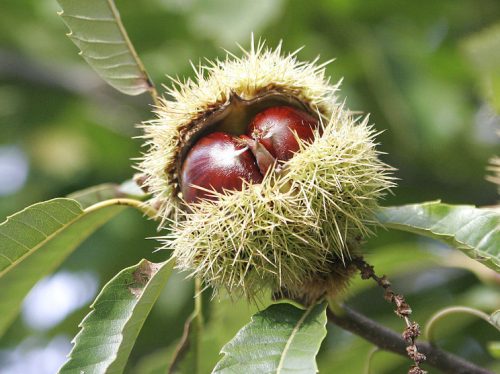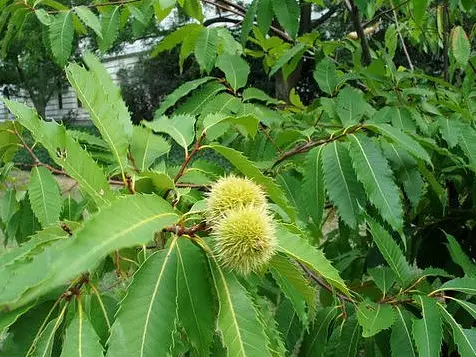Different types of trees with spiky seed balls are a fascinating and diverse group of tree species that captivate our attention with their unique reproductive structures. These trees exhibit a remarkable adaptation to disperse their seeds efficiently while protecting them from hungry animals.
The presence of spiky seed balls on these trees enhance their visual appeal and ecological significance. We wrote this article to provide detailed insights on the characteristics and management considerations of trees with spiky seed balls in urban landscape or parks.
Do Animals Eat Spiky Seeds Balls From Trees?
The natural world never ceases to amaze us with its extraordinary adaptations and intricate ecological relationships. Among the fascinating phenomena in nature is the consumption of spiky seed balls produced by certain trees.
Porcupine is a notable example due to its specialized digestive system that allows it to break down and extract nutrients from spiky seed balls. These seeds provide an essential source of food, particularly during times when other food options may be scarce.
Squirrels and chipmunks can also consume spiky seed balls due to their robust teeth and jaws. These small mammals can crack open the tough outer shells of the seed balls to access the nutritious contents inside.
I have also seen crossbills and grosbeaks feeding on spiky seed balls since they possess powerful beaks that can efficiently crack open the spiky shells to grant them access to valuable seeds. This adaptation allows birds to take advantage of food resources that may not be available to other animals.
The consumption of spiky seed balls serves important ecological functions as well. Animals that feed on these seeds inadvertently aid in the dispersal of tree species by transporting the seeds to new locations. This mutualistic relationship benefits both the animals, providing sustenance, and the trees, facilitating seed dispersal and colonization of new areas.
Different Types of Trees with Spiky Seed Balls
You might have encountered different kinds of trees with spiky seed balls while wandering in the woodlands or parks. Here is a comprehensive list of different types of trees with spiky seed balls:
American Beech (Fagus grandifolia)

It is a deciduous tree native to eastern North America. It is known for its distinctive spiny seed balls, which contain edible nuts favored by wildlife.
This tree typically reaches a height of 50 to 70 feet (15 to 21 meters) and has a rounded crown. The leaves of the American Beech are elliptical and have a smooth, wavy margin with prominent parallel veins.
The leaves turn into golden bronze color in the fall to boost the aesthetic appeal. The American Beech thrives in USDA hardiness zones 4 to 9, making it adaptable to a wide range of climates.
It is a valuable tree for providing shade and is often found in mixed forests throughout its native range. The beechnuts from these trees are edible.
London Plane Tree (Platanus x acerifolia)

It is a hybrid tree believed to have originated from a cross between the American Sycamore (Platanus occidentalis) and the Oriental Plane (Platanus orientalis). This deciduous tree is widely planted in urban areas due to its tolerance of pollution and ability to thrive in diverse environments.
The London Plane Tree produces distinctive spiny seed balls, which are spherical and hang from the branches throughout the year. These seed balls contain small, winged seeds that are dispersed by the wind.
London Plane Tree can grow up to 100 feet (30 meters) tall with a broad and spreading canopy. The trunk displays attractive mottled bark which peels off in patches to reveal a smooth cream, green, and brown surface.
These trees have palmately lobed leaves that resemble the shape of a maple leaf. The large deep green leaves have a diameter of around 4 to 8 inches (10 to 20 centimeters). During the fall, the leaves transition to vibrant shades of yellow, gold, and brown, creating a stunning autumn display.
The London Plane Tree is well-suited to a wide range of climates and can thrive in USDA hardiness zones 5 to 9. This adaptability makes it a popular choice for street plantings and urban landscapes, where it provides shade and enhances the aesthetics of the surrounding environment.
American Sycamore Tree (Platanus occidentalis)

It is a large, deciduous tree native to North America. It is commonly found along riverbanks, floodplains, and in moist woodlands throughout the eastern United States.
The tree produces distinctive spiny seed balls, which are round and approximately one inch in diameter. These seed balls hang from the tree’s branches and persist throughout the winter, eventually releasing tiny seeds in the spring.
The American Sycamore tree has an impressive stature and can grow up to 75-100 feet (23 to 30 meters) or more. It has a broad spreading crown that provides ample shade. The trunk is renowned for its characteristic mottled and flaky bark, which reveals patches of white, tan, and gray.
The large and palmately lobed leaves resemble the shape of a hand with three to five lobes. They can grow up to 10 inches (25 centimeters) in diameter and have a dark green color. During the fall season, the leaves turn various shades of yellow, orange, and brown before falling off.
The American Sycamore is adaptable to a range of climates and can thrive in USDA hardiness zones 4 to 9. It is particularly well-suited to moist and riparian environments but can also tolerate drier conditions.
American Sweet Gum (Liquidambar styraciflua)

It is a deciduous tree native to North America. The spiky seed balls are distinctive features also known as “spinners” or “gumballs.” These round, woody capsules contain numerous seeds and can be found hanging from the branches.
The tree itself can grow to impressive heights, reaching an average of 60 to 80 feet (18 to 24 meters) tall, although some specimens may exceed 100 feet (30 meters). Its crown has a symmetrical shape, providing ample shade and adding to its aesthetic appeal.
The palmately lobed and star-shaped leaves have five or seven lobes. The leaves turn vibrant shades of yellow, orange, and red during the autumn season, creating a stunning display of colors.
The American Sweet Gum is versatile and can thrive in a range of conditions. It is typically suited for USDA hardiness zones 5 to 9, encompassing a large portion of the United States.
Sweet Chestnut (Castanea sativa)

It is a deciduous tree native to parts of Europe and Asia. It is highly regarded for its cultural and economic significance, as well as its ornamental value.
This tree can reach impressive heights, with mature specimens growing up to 80 feet (24 meters) tall. It has a broad and rounded crown that provides ample shade.
The Sweet Chestnut does not produce spiny seed balls. But it produces prickly burrs or husks that contain multiple nuts, known as chestnuts. These husks have a spiky appearance and can be a bit prickly to handle.
The elongated and lance-shaped leaves have serrated edges. They have a glossy, dark green color during the summer and turn various shades of yellow and brown in the fall, creating a beautiful display.
The Sweet Chestnut thrives in temperate regions. It prefers mild and moist climates and is well-suited to USDA hardiness zones 5 to 9, although it can tolerate some variations within these zones.
American Chestnut Tree (Castanea dentata)

It is a deciduous tree that was once widespread in the eastern regions of North America. It is known for its spiky seed balls, distinctive leaves, impressive tree height, and unfortunate decline due to a devastating disease.
The tree produces spiky seed balls or burrs that are covered in sharp, slender spines. These burrs contain multiple nuts or chestnuts, which are encased within a leathery husk. The spiky appearance of the seed balls helps to protect the nuts from being easily consumed by animals.
The leaves of the American Chestnut are long, lance-shaped, and have serrated edges. They have a dark green color during the summer and turn yellow or brown in the fall, creating a beautiful display of autumn foliage.
Mature trees can reach heights of up to 100 feet (30 meters) or more with a straight trunk and a broad spreading crown. The American Chestnut is adapted to zones 4 to 8, which cover a considerable portion of the eastern United States.
Horse Chestnut Tree (Aesculus hippocastanum)

It is a deciduous tree native to parts of southeastern Europe. It is valued for its majestic stature, distinctive spiky seed balls, large leaves, and ornamental qualities.
The spiky seed balls also called “conkers” or “buckeyes” are distinctive features. The spines are the protective barrier for the seeds to prevent animals from accessing them.
The large leaves have palmately compound leaflets with each leaf having five to seven leaflets with serrated edges. The leaves have a bright green color during the summer months and turn yellow or brown in the autumn before falling from the tree.
The Horse Chestnut can grow up to 80 feet (24 meters) tall with a rounded crown, making it an impressive and visually appealing tree in the landscape. The tree is well-suited to USDA hardiness zones 4 to 7.
It thrives in temperate climates and prefers moist, well-drained soils. While it can tolerate a range of soil types, it tends to perform best in fertile soils. It is widely planted as an ornamental tree in parks, and gardens.
Buckeye Tree (Aesculus glabra)

It is a deciduous tree native to eastern and central parts of North America. It is recognized for its unique spiky seed balls, moderate tree height, distinctive leaves, and preferred USDA hardiness zones.
It produces spiky seed balls or capsules that contain one or two large, shiny brown seeds. These seed balls have a rough, textured appearance due to their spiny husks. They are commonly referred to as “buckeyes” and are often considered a symbol of good luck.
The Buckeye Tree has an average height of 30 to 60 feet (9 to 18 meters) tall. Its crown has a rounded or oval shape, providing shade and adding to its aesthetic appeal.
The palmately compound leaves have five to seven leaflets arranged in a fan-like pattern. The leaflets have serrated edges and a deep green color. The Buckeye Tree is well-suited to USDA hardiness zones 4 to 7.
The Buckeye Tree is often planted as an ornamental tree in parks, gardens, and along streets for its attractive foliage and unique seed balls. It also provides habitat and food for various wildlife species like birds and squirrels.
It’s worth mentioning that while the seeds of the Buckeye Tree are not toxic like those of its European counterpart, the Horse Chestnut, they are not suitable for consumption by humans and should be handled with care.
How to Get Rid of Trees with Spiky Seed Balls
If you’re looking to get rid of trees with spiky seed balls, it’s important to approach the process carefully and responsibly. Here are some methods you can consider:
Pruning and Trimming
Regular pruning and trimming can help control the growth and spread of trees. By removing branches and seed ball clusters, you can minimize the production of spiky seed balls. But this method may not entirely eliminate the problem since some trees have abundant seed ball production.
Mechanical Removal
You can manually remove the tree and its spiky seed balls by cutting them down using a saw or chainsaw. Be sure to wear protective gear and be mindful of falling branches.
Professional Tree Removal
We recommend hiring professional tree removal services when dealing with larger trees or lacking the necessary equipment and expertise. They can safely and effectively remove the tree, including its spiky seed balls, ensuring the process is handled properly.
Chemical Control
Herbicides or systemic tree control products can be used as a last resort. Consult with a professional arborist or local gardening center to identify suitable herbicides for your specific tree species. Follow all safety instructions and consider the potential impact on the surrounding environment before using any chemical control methods.
Preventive Measures
We recommend removing the fallen seed balls more often instead of removing the existing tree. Pruning will also help minimize seed ball production to limit its spread and germination.
Final Thoughts From Experts
Different types of trees with spiky seed balls are a distinct group of tree species that possess unique characteristics and considerations. The presence of spiky seed balls can add visual interest to the tree and contribute to its ecological and reproductive strategies.
Methods for managing trees with spiky seed balls can include pruning and trimming to reduce seed ball production, mechanical removal for smaller trees, professional tree removal for larger trees, chemical control as a last resort, and preventive measures such as regular cleanup and pruning.
We recommend identifying the tree species and understand its growth habits and specific requirements for removal. Selective pruning or seeking advice from professionals can help strike a balance between managing spiky seed balls and preserving the benefits that trees provide.
People Who Read This Also Read:






